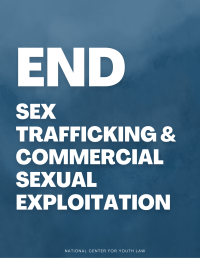Counties Across California Explore Multi-Agency Responses to CSEC
by Elizabeth Laferriere, MPP
Historically, commercially sexually exploited children (CSEC) have been regarded as juvenile delinquents, labeled “child prostitutes” and had to be arrested to access even basic services. Advocates have long recognized this as incredibly harmful to youth; by treating exploited children as criminals rather than victims, the state re-traumatizes them and fails to appropriately address their needs. The National Center for Youth Law (NCYL) and its many partners have taken steps to correct this by helping to pass Senate Bill (SB) 855, allowing children in California who have been commercially sexually exploited to be served by the child welfare system, a system designed to protect and serve abused and neglected children. Following the passage of SB 855, counties across California are reforming their systems to identify and treat CSEC as victims of abuse in need of trauma-informed, victim-centered, and multidisciplinary services.
Enacted in 2014, SB 855 provides both structure and incentives to encourage county agencies to collaborate in identifying and serving CSEC. SB 855 clarified that exploited children and children who are forced to trade sex to meet their basic needs may be served through the child welfare system as victims of child abuse and neglect. It also established the opt-in CSEC Program, designed by NCYL and the CSEC Action Team (a committee of the California Child Welfare Council staffed by NCYL). The CSEC Program requires participating counties to develop an interagency protocol for CSEC case management, planning, and delivery of services. The law designates specific agencies to collaborate in the protocol’s development and mandates a multidisciplinary teaming (MDT) approach. CSEC Program counties receive state funding to support their efforts and must re-apply each year.
The idea behind the CSEC Program was to increase the number of counties in California effectively serving CSEC. During the early stages of this Program, it has become clear that for most counties, putting this idea into practice requires new and significant levels of cross-agency coordination. Counties need guidance navigating this process, drafting protocols, and meeting SB 855’s requirements. NCYL has addressed these challenges by capitalizing on the diverse expertise of the state’s CSEC Action Team in order to create a number of resources. These resources not only explain the statutory requirements of the CSEC Program, but also include promising practices from the CSEC Action Team’s extensive research on approaches used in other jurisdictions. The guidance is not exclusive to the CSEC Program, and may be utilized by any county, including those outside of California, for the purpose of improving systems response to CSEC.
Many of these resources are now available for the first time in one comprehensive guide: Improving California’s Multi-System Response to CSEC: Resources for Counties. This toolkit contains the following:
- Executive Summary: this summary defines the scope of the CSEC Problem in California and includes recommendations from Ending the Commercial Sexual Exploitation of Children: A Call for Multi-System Collaboration in California, a 2013 report written by NCYL staff attorney Kate Walker Brown. This report and the advocacy efforts surrounding it were the impetus for creating the CSEC Action Team.
- Memorandum Summarizing the Available Screening Tools to Identify CSEC: this resource was created for the CSEC Action Team by the WestCoast Children’s Clinic. Recognizing the importance of using a systematic screening tool, WestCoast Children’s Clinic completed a survey of available screening and identification tools. These screening tools, often in the form of interviews or indicator checklists, are employed by various child-serving agencies to detect exploitation or heightened risk among children. WestCoast Children’s Clinic compared 15 CSEC screening tools and evaluated them using criteria including: format, length, validation status, intended population, form of trafficking, and domain application (e.g., specific to juvenile justice or universal). The analysis uncovered that not a single tool in the United States has been validated to identify CSEC, which highlighted the need for such a tool. As a result, WestCoast Children's Clinic developed the Commercial Sexual Exploitation-Identification Tool (CSE-IT), which is now being piloted by county agencies and community-based organizations across California. The validation process should be complete by the spring of 2016.
- Model Interagency Protocol Framework: disseminated to counties through an All County Information Notice in April by the California Department of Social Services (CDSS), this resource includes: (1) Background & Purpose, which explains the CSEC Action Team and the stimulus for creating these resources; and the (2) Model Interagency Protocol Framework, which describes the legal requirements of the CSEC Program and offers additional guidance on the infrastructure that should be in place to embark on the reform, including the formation of a steering committee to oversee the county program. This tool helped shape early county dialogue with regard to which agencies should be at the table for the process of developing the protocol.
- CSEC Practice Guidance Toolkit: disseminated to counties in May by CDSS, this resource includes: (1) MOU Template for the CSEC Program, which expands upon the Framework and can be used by counties when developing their interagency protocols; (2) Holistic Needs of CSEC, which serves as a reference point for identifying what needs should be considered in coordinated case planning; and (3) Core Competencies for Serving CSEC, which outlines the skills and knowledge that will help providers identify, serve, and protect children who have been sexually exploited or are vulnerable to exploitation.
County steering committees have been meeting since the spring of 2015 and using these resources to fulfill CSEC Program deadlines. In June 2015, 35 counties that opted to participate in the 2015-2016 CSEC Program submitted plans to CDSS outlining the county’s current and future approach to CSEC. Using a methodology that emphasized prevalence and preparedness, CDSS evaluated the County Plans to determine the level of funding each county would receive. CDSS selected 22 for the higher level, or “Tier II,” funding. Tier II funding ranged from nearly $30,000 up to just under $2.8 million. The remaining 13 counties were awarded $25,000 in Tier I funding. Tier II counties submitted complete interagency protocols to CDSS by October 1. Many adapted the MOU Template resource for their final submission.
Three of these counties benefited from NCYL’s direct involvement in their protocol development: San Francisco, Santa Clara and the Tri-County region (Monterey, San Benito, and Santa Cruz). All three received Tier II funding with awards ranging from $158,000 for the Tri-County area to $555,000 each for San Francisco and Santa Clara.
In Los Angeles, the recipient of the largest Tier II allocation of nearly $2.8 million, NCYL’s direct engagement predates SB 855. NCYL began drafting the county’s acclaimed Law Enforcement First Responder Protocol in 2013, which continues to shape the area’s innovative response to CSEC. NCYL staff are currently authoring Los Angeles’s Interagency Juvenile Hall Protocol for CSEC, which will be used to identify and serve CSEC in the juvenile hall and ensure a smooth transition back to the community; and the Victim Witness Protocol, which will promote a victim-centered process for assessing whether and how children should testify in a case against their exploiter.
On October 21, Los Angeles launched the No Such Thing as a Child Prostitute Campaign in collaboration with the Human Rights Project for Girls and the California Endowment. At the event, county leadership urged agencies to stop the practice of arresting CSEC in Los Angeles. The following day Los Angeles County Sheriff Jim McDonnell announced that his department will stop arresting CSEC. Such a commitment would not have been possible without the First Responder Protocol and the interagency coordination and trust that were fortified during its development.
NCYL will support ongoing SB 855 implementation through technical assistance, guidance on state policy, and the creation of multidisciplinary resources through the CSEC Action Team. Independently, NCYL is developing two new tools for counties that should be completed by the spring of 2016:
- Mandatory Reporting Guidebook for CSEC: most mandated reporters are not yet trained to identify and report CSEC as victims of child abuse. This guide will incorporate CSEC into the reporters’ framework of responsibilities so that they can fulfill their mandate.
- CSEC Data Memorandum: there is widespread confusion among counties around the different data collection and reporting requirements established by SB 855 and SB 794, California’s compliance response to HR 4980 (Preventing Sex Trafficking and Strengthening Families Act), the federal legislation in this area. NCYL is producing a comparison chart that will make it easier for county agencies to understand and fulfill the unique requirements of both SB 855 and HR 4980.
Finally, on behalf of the CSEC Action Team, NCYL is helping coordinate the Tier II county convening at December’s Beyond the Bench Conference, a multidisciplinary statewide conference devoted to children, youth, and families in the California court system. The CSEC Action Team is also developing a survivor advisory board that will enable survivors to meaningfully inform statewide CSEC efforts.






